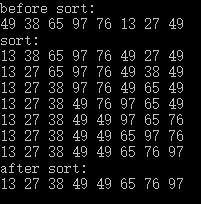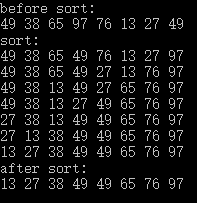跟冒泡排序有点相似,冒泡排序是符合条件直接进行交换,而选择排序则是将索引记录下,一轮比较完成后再进行交换。
找最小元素
1
2
3
4
5
6
7
8
9
10
11
12
13
14
15
16
17
18
19
20
21
22
23
24
25
26
27
28
29
30
31
32
33
34
35
36
37
38
39
40
41
42
43
44
45
46
47
48
49
50
| #include <iostream>
#include <vector>
using namespace std;
void SelectionSort(vector<int>& vec);
void Print(const vector<int>& vec);
int main()
{
vector<int> vec = { 49, 38, 65, 97, 76, 13, 27, 49 };
cout << "before sort:" << endl;
Print(vec);
cout << "sort:" << endl;
SelectionSort(vec);
cout << "after sort:" << endl;
Print(vec);
}
void SelectionSort(vector<int>& vec)
{
int length = vec.size();
int minIndex;
for( int i = 0; i < length - 1; i++ )
{
minIndex = i;
for( int j = i + 1; j < length; j++ )
{
if( vec[j] < vec[minIndex] )
{
minIndex = j;
}
}
if( minIndex != i )
{
swap(vec[i], vec[minIndex]);
}
Print(vec);
}
}
void Print(const vector<int>& vec)
{
for( int v : vec )
{
cout << v << " ";
}
cout << endl;
}
|

找最大元素
跟上者的过程相反,代码看起来会没上者的简洁。
1
2
3
4
5
6
7
8
9
10
11
12
13
14
15
16
17
18
19
20
21
22
23
24
25
26
27
28
29
30
31
32
33
34
35
36
37
38
39
40
41
42
43
44
45
46
47
48
49
50
| #include <iostream>
#include <vector>
using namespace std;
void SelectionSort(vector<int>& vec);
void Print(const vector<int>& vec);
int main()
{
vector<int> vec = { 49, 38, 65, 97, 76, 13, 27, 49 };
cout << "before sort:" << endl;
Print(vec);
cout << "sort:" << endl;
SelectionSort(vec);
cout << "after sort:" << endl;
Print(vec);
}
void SelectionSort(vector<int>& vec)
{
int length = vec.size();
int maxIndex;
for( int i = 0; i < length - 1; i++ )
{
maxIndex = length - 1 - i;
for( int j = length - 1 - i - 1; j >= 0; j-- )
{
if( vec[j] > vec[maxIndex] )
{
maxIndex = j;
}
}
if( maxIndex != length - 1 - i )
{
swap(vec[length - 1 - i], vec[maxIndex]);
}
Print(vec);
}
}
void Print(const vector<int>& vec)
{
for( int v : vec )
{
cout << v << " ";
}
cout << endl;
}
|

打印出来的排序过程跟上者是不同的。



